Tattoo questions answered
Published 11:04 am Wednesday, March 4, 2015
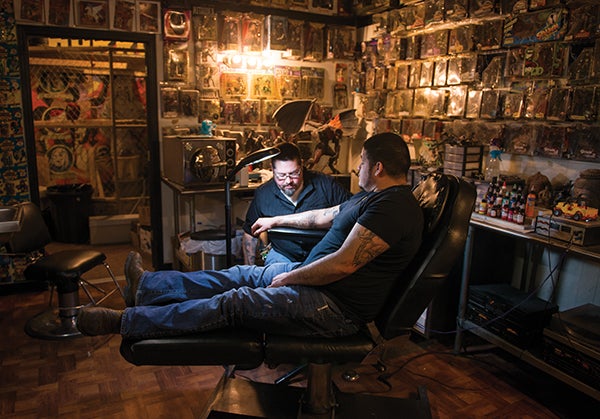
Gilbert Johnson Jr., owner of The Chapel in Albert Lea, tattoos Junior Chavez of Owatonna. – Colleen Harrison/Albert Lea Tribune
Artists share what to know before a 1st ink appointment
Considering getting your first tattoo and don’t know where to begin? Want to get something meaningful but don’t know what to pick as a design?
Albert Lea magazine sat down with the two licensed tattoo artists in town to get the ins and outs of tattoos.
Gilbert Johnson Jr. is arguably one of the most well known tattoo artists in the area and owns The Chapel, 115 S. Broadway.
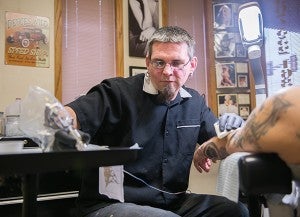
Anson Eklund prepares to tattoo Jeremy Shafer of Austin at Kat’s Tats in Albert Lea. – Colleen Harrison, Albert Lea Tribune
Anson Eklund of Kat’s Tats, 115 W. College St., is growing in popularity and has been with the business for three years.
Here are the questions and answers we asked the artists:
Q: I have never had a tattoo before and am considering getting one. How should I choose what to get?
Johnson advised people to pick out a design that means something to them and to start small so they can see what they’re getting into.
“There’s a lot of anxiety involved,” he said. “Don’t go with a trend.”
Once people find out what it feels like to get a tattoo, then he said they can “go crazy.”
“Ultimately it’s their body, and they can do what they want,” Johnson said.
He said people can bring in an idea for their tattoo or he can help them come up with one based off of what they might like.
Eklund said he advises people against simply randomly selecting an image off the wall of the tattoo studio, particularly for their first tattoo.
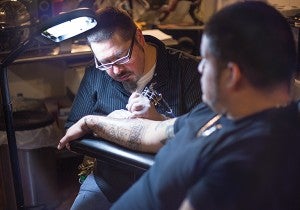
Johnson has owned the building that houses his tattoo parlor for about 15 years. In that time he said he has seen a number of other tattoo shops come and go in town. – Colleen Harrison/Albert Lea Tribune
He said he tells people coming in for the first time that the experience will likely be nothing like what they imagine.
“Ninety-nine percent of what you think, it’s going to be wrong,” Eklund said.
While he describes the pain during the tattoo process as an “irritation,” it varies from person to person and where you get the tattoo.
Q: I just got my first tattoo. How do I take care of it now that I have it?
Johnson said once the tattoo is finished, it will feel like a sunburn. The bandage should remain on the tattoo for no more than a half hour. After that, carefully remove and dispose of the bandage, and then gently clean the tattoo using a clean washcloth with warm soapy water to remove all of the dried blood and ointment.
He suggested using products such as Aquafor, triple antibiotic or A&D ointment to keep the tattoo moist.
The tattoo should be left open to the air as much as possible.
“Don’t itch it, pick it or scratch it because you lose ink,” Johnson said.
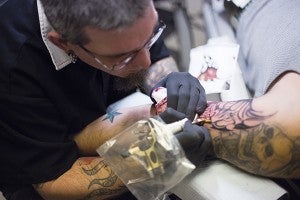
Eklund stressed the importance of going to a professional when getting tattoos and piercings and other body modifications. Colleen Harrison/Albert Lea Tribune
He said to avoid swimming, soaking in a tub or letting the shower beat directly on the tattoo until it is completely healed.
Eklund recommended using A&D ointment for the first two to three days after getting the tattoo and then switching to lotion.
“Don’t touch it. Don’t touch it. Don’t touch it,” he said.
Q: Has the perception of tattoos changed?
Though there is still some stigma surrounding tattoos, Johnson said he thinks the perception has changed even in the last five years.
“They finally see it as art and not as a biker thing,” he said, noting that it used to be mainly associated with bikers and criminals.
“We’re not all criminals,” Eklund echoed. “And they don’t all hurt.”
Johnson said now even his own mother — who was against him getting his first tattoo — has eight tattoos of her own, and he has completed tattoos on people all the way up to age 80.
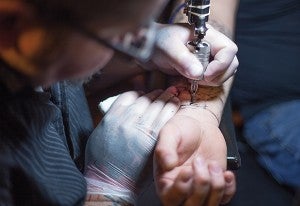
Johnson said he has been drawing for most of his life, and has been tattooing for about 24 years. – Colleen Harrison/Albert Lea Tribune
“It’s so different now than it used to be,” he said.
Eklund said he thinks some stigma remains, though he wishes people would see that more and more people from all walks of life are getting inked these days.
He, personally, has inked people ranging in age from 18 to 68.
Q: What do tattoo studios have to do to get licensed?
The application for a license at a studio in Minnesota costs well over $1,000 from the Minnesota Department of Health, Johnson estimated. This is significantly higher than at one time when he recalled it was only $25.
He said inspectors come twice a year to check out the studio — once scheduled and once as a surprise.
They check for cleanliness and to make sure paperwork is up-to-date.
He said his autoclave, the machine used for sterilization, has to be tested once a month to make sure it is working properly.
Both men advised against getting a tattoo from someone who is not licensed because these “backyard artists” do not know how to take care of the skin during the tattoo process or how to clean equipment properly.
People can view licensed establishments online through the Minnesota Department of Health.
10 tattoo care tips
• Leave your bandage in place for no more than a half hour.
• Carefully remove and dispose of your bandage.
• Gently damp clean your tattoo using a clean washcloth and warm soapy water to remove all of the dried blood and ointment.
• Apply a thin layer of ointment (triple antibiotic, A&D, Black Cat, Tattoo Goo) as often as necessary to keep your tattoo moist.
• Leave your tattoo open to air as much as possible.
• Cover your tattoo when wearing tight-fitting clothing to prevent rubbing or irritation
• Do not swim, soak in tub or let shower beat directly down on your tattoo until completely healed, which normally takes seven to 30 days without scabbing.
• Do not pick or scratch at your tattoo or get sunburned for at least 30 days.
• For protection from the sun, use SPF 30 or greater sub lock or sunscreen.
• If skin is dry or dull looking, apply quality skin lotions, baby oils or vitamin E oils.
10 tattoo care tips
• Leave your bandage in place for no more than a half hour.
• Carefully remove and dispose of your bandage.
• Gently damp clean your tattoo using a clean washcloth and warm soapy water to remove all of the dried blood and ointment.
• Apply a thin layer of ointment (triple antibiotic, A&D, Black Cat, Tattoo Goo) as often as necessary to keep your tattoo moist.
• Leave your tattoo open to air as much as possible.
• Cover your tattoo when wearing tight-fitting clothing to prevent rubbing or irritation
• Do not swim, soak in tub or let shower beat directly down on your tattoo until completely healed, which normally takes seven to 30 days without scabbing.
• Do not pick or scratch at your tattoo or get sunburned for at least 30 days.
• For protection from the sun, use SPF 30 or greater sub lock or sunscreen.
• If skin is dry or dull looking, apply quality skin lotions, baby oils or vitamin E oils.





